The Economics and Statistics Division maintains archives of previous publications for accountability purposes, but makes no updates to keep these documents current with the latest data revisions from Statistics Canada. As a result, information in older documents may not be accurate. Please exercise caution when referring to older documents. For the latest information and historical data, please contact the individual listed to the right.
<--- Return to Archive
For additional information relating to this article, please contact:
April 29, 2022CANADA GDP BY INDUSTRY, FEBRUARY 2022 Real Gross Domestic Product (GDP) in Canada increased 1.1% month-over-month to an annualized value of $2,041 billion (chained 2012 dollars) in February 2022. This was the ninth consecutive month-over-month increase and the largest gain since March 2021. Activity rose in 16 of 20 industrial sectors. Both goods-producing (+1.5%) and services-producing industries (+0.9%) increased in February compared to last month.
Statistics Canada’s preliminary estimate for March 2022 real GDP shows a 0.5% gain. Further reopening of activities and eased restrictions supported client-facing industries. Manufacturing and construction recorded increases while wholesale was down. The official GDP data for March 2022 will be published on May 31, 2022.
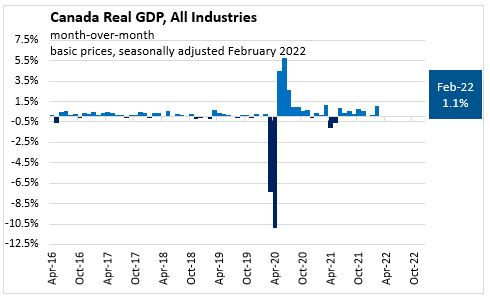
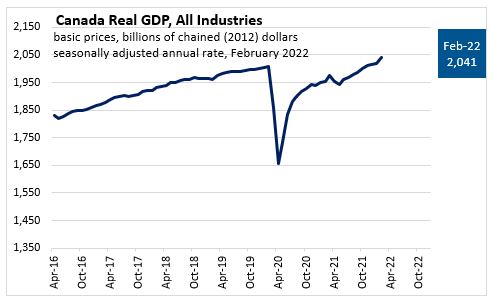
Goods-Producing Industries
Goods-producing sector output increased 1.5% month-over-month in February 2022.
Construction rose for a second month with a 2.7% gain. Residential building construction increased 3.7% due to home alterations and apartment building construction. Non-residential construction gained for an eighth consecutive month with alteration and improvement spending and several new manufacturing and maintenance buildings in Ontario and Quebec.
All subsectors in mining, quarrying, and oil and gas extraction were up as the sector grew 3.4% in February. Oil sands extraction grew following the production disruptions last month. Oil and gas extraction (except oil sands) rose 2.9% with higher extraction of crude petroleum and natural gas. Mining and quarrying growth was led by coal mining (+27.1%) gaining double-digits for the third month in a row as rail movements and exports recovered from the flooding in British Columbia. All types of metal ore mining were up and non-metallic mineral mining growth was led by potash mining.
Utilities declined 2.3% in February following strong growth in January when there were below seasonal temperatures in many parts of the country.
Services-Producing Industries
Output of the services-producing sector grew 0.9% in February 2022.
With the Omicron wave and associated restrictions beginning to subside, client-facing industries picked up. Accommodation and food services rose 15.1%, offsetting most of the decline of the previous 2 months. Arts, entertainment and recreation bounced back with increases in all subsectors and overall growth of 8.4%.
Rail transportation gained 9.1%, its largest increase since May 2014, as activity picked up after the British Columbia floods and more typical weather in the month. Urban transit systems nearly recovered from lower ridership the previous two months. Air transportation and support activities for transportation were both up.
Offices of real estate agents and brokers (+2.5%) gained on home resale activity, led by Ontario and Prairie provinces. Legal services, which derive a lot of activity from real estate transactions, also were up. Depository credit intermediation (+0.5%) rose with home buyers moving to lock in lower mortgage rates ahead of expected increases.
Wholesale trade declined 1.1% following six months of growth. Personal and household goods wholesaling contributed the most due to lower imports of pharmaceuticals (including COVID-19 medicine for re-export). Following on 3.0% growth in January, retail trade declined 0.2% with 7 of 10 subsectors down. Motor vehicles and parts dealers contracted after elevated activity last month while clothing store activity rose to mostly offset the lower levels in the previous two months.
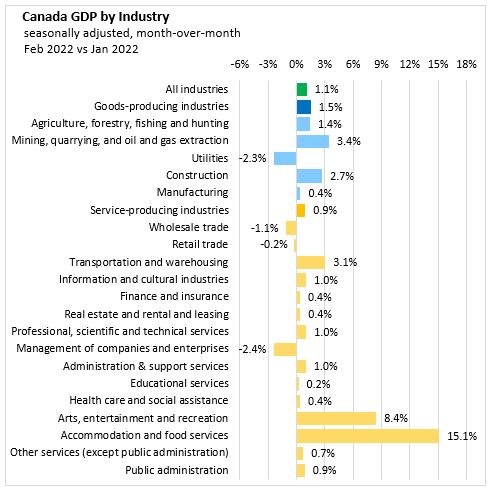
February 2022 vs February 2020
Canadian real GDP was 1.5% higher when compared to February 2020.
Amid the COVID-19 pandemic and recovery to date, the service sectors with the current largest declines in activity are in management of companies and enterprises (-50.5%), arts, entertainment and recreation (-25.3%), transportation and warehousing (-12.8%), and accommodation and food services (-11.0%) . For February 2022, all goods-producing industries were at lower levels of activity than February 2020 except construction (+5.3%), and agriculture, forestry, fishing and hunting (+1.2%).
Activity has increased the most in finance and insurance (+7.9%), professional, scientific and technical services (+6.6%), and construction (+5.3%).
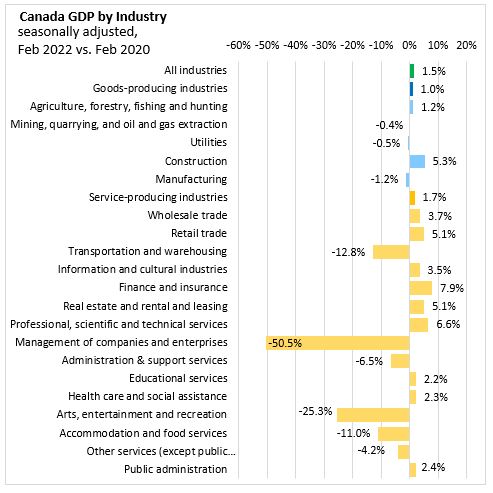
Year-to-Date (Jan-Feb 2022 vs Jan-Feb 2021)
The Canadian economy was 4.1% larger in January-February 2022 when compared to the same months in 2021.
Compared to January-February 2021, the largest increases in activity have been in arts, entertainment and recreation (+43.2%), accommodation and food services (+31.0%), and other services (+7.9%).
Activity decreased in management of companies (-30.6%) and agriculture, forestry, fishing and hunting (-0.7%).
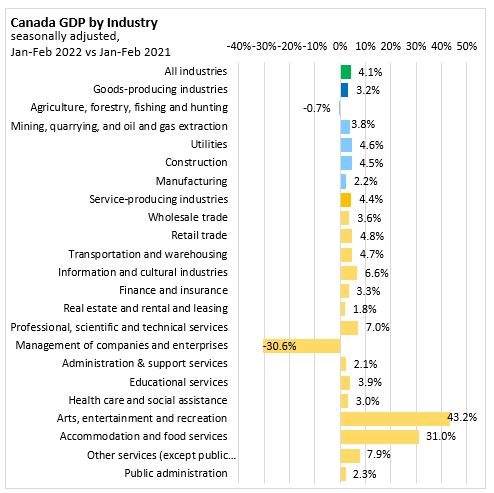
Source: Statistics Canada, Table 36-10-0434-01 Gross domestic product (GDP) at basic prices, by industry, monthly (x 1,000,000)
<--- Return to Archive